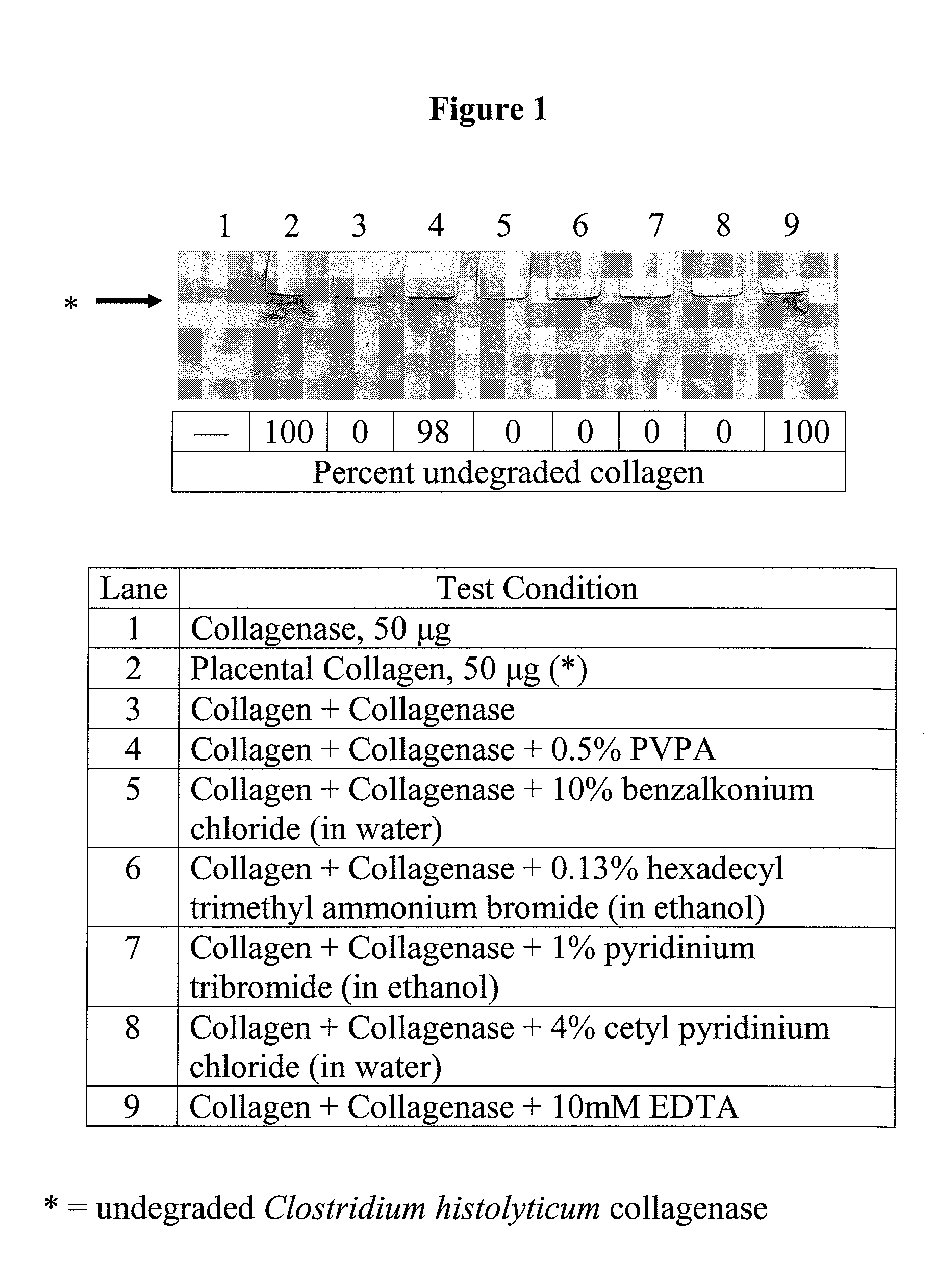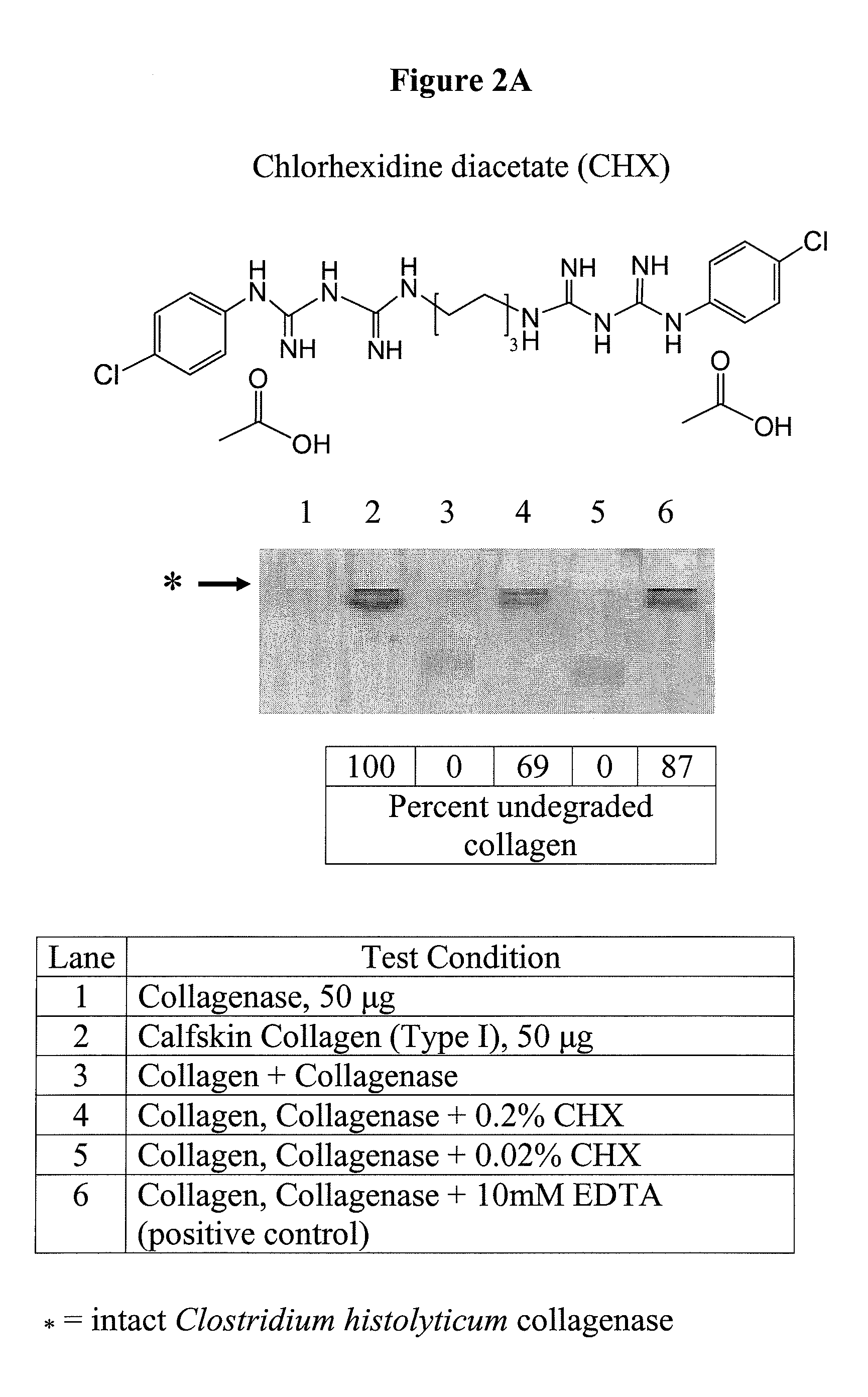Use of Quaternary Ammonium Compounds to Inhibit Endogenous MMPs in Tooth Dentin
a technology of quaternary ammonium compounds and endogenous mmps, which is applied in the direction of amide active ingredients, drug compositions, tooth capping, etc., can solve the problems of difficult bonding of adhesive resins to dentin, reducing the permeability of dentin to adhesive, and rarely achieving ideal results. , to prevent degradation of resin-dentin bond, soften the bond, and weaken the bond
- Summary
- Abstract
- Description
- Claims
- Application Information
AI Technical Summary
Benefits of technology
Problems solved by technology
Method used
Image
Examples
example 1
Assays Used to Screen Compounds of Interest for Anti-MMP Activity
[0205]Bacterial collagenase-based anti-MMP screening assay: This assay employs purified Clostridium histolyticum collagenase (hereinafter “collagenase”) as the test enzyme for screening anti-MMP activity of compounds of interest. The screening assay involves incubating a constant concentration of collagenase with Type I soluble collagen and quantifying the amount of Type I collagen that remains undegraded in the presence of collagenase in the presence and absence of different test compounds. The basic assay composition comprises 50 μg of Type I collagen (e.g., human placental; Cat. # C7521; Sigma-Aldrich, St. Louis, Mich., USA) and 50 μg of collagenase (e.g., Clostridium histolyticum E.C. 3.4.24.3; Cat. No. C7667 (1909 CDU / mg solid); Sigma-Aldrich, St. Louis, Mich., USA) in a physiological buffer (pH 7.4) containing zinc ions, with a total reaction volume of 60 μl. This amount of collagenase is sufficient to solubilize...
example 2
Initial Evaluation of Known Antibacterial Compounds Using the Bacterial Collagenase-Based Anti-MMP Screening Assay.
[0213]A number of known antibacterial compounds were assayed using the bacterial collagenase-based anti-MMP screening assay described in Example 1. FIG. 1 shows an SDS-PAGE gel upon which the assayed test compounds were run and quantitated from. These experiments revealed that PVPA (0.5 wt %) inhibited collagenase 98%. This is similar to the 10 mM EDTA control lane, which inhibited collagenase 100%. However, benzalkonium chloride (10%), hexadecyl trimethyl ammonium bromide in ethanol (0.15%), pyridinium tribromide (1%) and cetyl pyridinium chloride in water (4%) had no inhibitory activity against collagenase.
example 3
Quantitative Evaluation of Compounds Using the Bacterial Collagenase-Based Anti-MMP Screening Assay.
[0214]Additional test compounds were screened using the bacterial collagenase-based anti-MMP screening assay described in Example 1. For example, see FIG. 2, Panels A and B, showing exemplary SDS-PAGE electrophoresis gels upon which samples were run to assess the anticollagenolytic activity of CHX and METMA. The compounds tested and the results of these experiments are summarized in Table 1.
[0215]FIG. 2A shows the inhibitory activity of 0.02 and 0.2% chlorhexidine diacetate (CHX), a biguanide agent on Clostridium histolyticum collagenase. At a concentration of 0.02%, CHX did not inhibit collagenase (lane 5). However, at a concentration of 0.2%, CHX inhibited collagenase 69%. In lane 6, 10 mM EDTA inhibited collagenase 87%.
[0216]FIG. 2B shows the inhibitory activity of [2-(methacryloxy)ethyl] trimethyl ammonium chloride (METMAC), a polymerizable quaternary ammonium derivative of methac...
PUM
| Property | Measurement | Unit |
|---|---|---|
| Percent by mass | aaaaa | aaaaa |
| Mass | aaaaa | aaaaa |
| Molar density | aaaaa | aaaaa |
Abstract
Description
Claims
Application Information
 Login to View More
Login to View More - R&D
- Intellectual Property
- Life Sciences
- Materials
- Tech Scout
- Unparalleled Data Quality
- Higher Quality Content
- 60% Fewer Hallucinations
Browse by: Latest US Patents, China's latest patents, Technical Efficacy Thesaurus, Application Domain, Technology Topic, Popular Technical Reports.
© 2025 PatSnap. All rights reserved.Legal|Privacy policy|Modern Slavery Act Transparency Statement|Sitemap|About US| Contact US: help@patsnap.com



